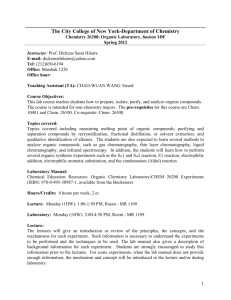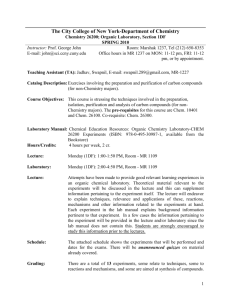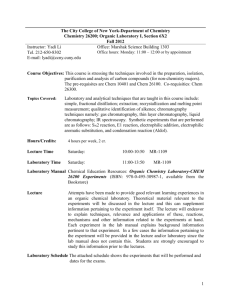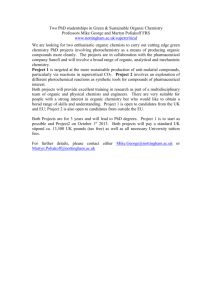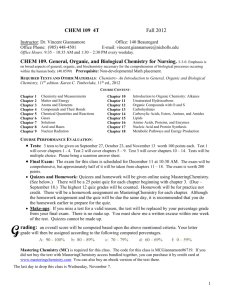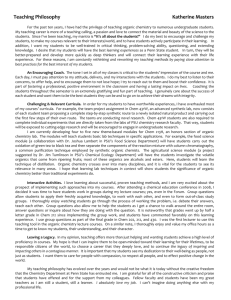Chemistry 26200 - The City College of New York
advertisement
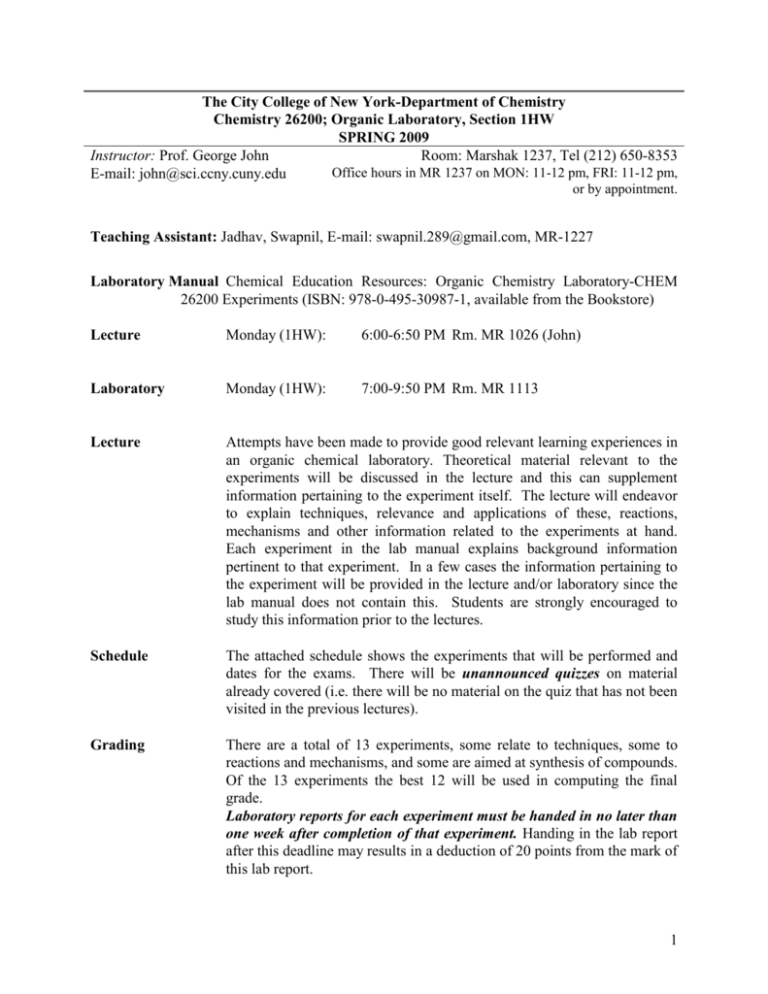
The City College of New York-Department of Chemistry Chemistry 26200; Organic Laboratory, Section 1HW SPRING 2009 Instructor: Prof. George John Room: Marshak 1237, Tel (212) 650-8353 Office hours in MR 1237 on MON: 11-12 pm, FRI: 11-12 pm, E-mail: john@sci.ccny.cuny.edu or by appointment. Teaching Assistant: Jadhav, Swapnil, E-mail: swapnil.289@gmail.com, MR-1227 Laboratory Manual Chemical Education Resources: Organic Chemistry Laboratory-CHEM 26200 Experiments (ISBN: 978-0-495-30987-1, available from the Bookstore) Lecture Monday (1HW): 6:00-6:50 PM Rm. MR 1026 (John) Laboratory Monday (1HW): 7:00-9:50 PM Rm. MR 1113 Lecture Attempts have been made to provide good relevant learning experiences in an organic chemical laboratory. Theoretical material relevant to the experiments will be discussed in the lecture and this can supplement information pertaining to the experiment itself. The lecture will endeavor to explain techniques, relevance and applications of these, reactions, mechanisms and other information related to the experiments at hand. Each experiment in the lab manual explains background information pertinent to that experiment. In a few cases the information pertaining to the experiment will be provided in the lecture and/or laboratory since the lab manual does not contain this. Students are strongly encouraged to study this information prior to the lectures. Schedule The attached schedule shows the experiments that will be performed and dates for the exams. There will be unannounced quizzes on material already covered (i.e. there will be no material on the quiz that has not been visited in the previous lectures). Grading There are a total of 13 experiments, some relate to techniques, some to reactions and mechanisms, and some are aimed at synthesis of compounds. Of the 13 experiments the best 12 will be used in computing the final grade. Laboratory reports for each experiment must be handed in no later than one week after completion of that experiment. Handing in the lab report after this deadline may results in a deduction of 20 points from the mark of this lab report. 1 There will be one mid-term exam (worth 75 points) and one final (worth 100 points). There will be 6 unannounced quizzes (each worth 10 points). These will be administered at the beginning of a lecture. Of these, the best 5 quiz grades will be used for calculation of the final grade. Student performance will be evaluated by the TA and is worth a total of 25 points. A summary of the points assigned to each portion of the course is shown below. Note that the exams and quizzes constitute ~40% of the grade while the laboratory activities constitute ~60%. Experiments 13 in all, best 12/13 x 25 points each Quizzes 6 in all, best 5/6 x 10 points each Mid-term exam, 75 points Final exam (comprehensive), 100 points TA evaluation, 25 points TOTAL POINTS FOR THE COURSE = 300 points = 50 points = 75 points = 100 points = 25 points = 550 points (100%) THERE ARE NO MAKEUP LABS AND NO MAKEUP EXAMS OR QUIZZES. ABSENCE WITHOUT A STRONG, VERIFIABLE, DOCUMENTED REASON WILL RESULT IN ZERO POINTS FOR THE MATERIAL MISSED. LAB REPORTS NOT SUBMITTED IN A TIMELY MANNER WILL ALSO RESULT IN ZERO POINTS FOR THAT EXERCISE. Safety issues You must wear lab goggles at all times in the lab. Do not wear shorts or short skirts without a lab coat; this is for your safety! Similarly, open shoes and slippers should not be worn. You are STRONGLY encouraged bring your own latex gloves to the lab. YOUR workplace should be CLEAN always! Breakage Students must be aware of the fact that they will be charged for the replacement cost of any equipment that they break during the lab course. Some of the glassware is especially expensive and so you are urged to work carefully at all times. If you have questions, comments or suggestions please contact you teaching assistant or the instructor. 2 Laboratory reports All your lab work should be recorded in a lab notebook and NOT on scraps of paper. Data recorded in the notebook must be properly dated, and neatly written. Based on this information, you will generate a laboratory report that will be submitted for grading. This exercise provides experience with accurate data management and report writing. A general format for the laboratory report is provided below. 1 2 3 4 5 6 7 8 9 10 Name, ID number and section Title of experiment Aim of experiment Reaction and Mechanism: Any equations chemical structures relevant to the experiment as well as any pertinent mechanisms. Physical Properties: A table listing the compounds used, their molecular weights, amounts used in grams and moles, boiling points and density (for liquids), as applicable Hazards: determine flammability, toxicity or corrosiveness of the compounds used in this experiment. 5 5 5 10 Limiting Reagent: Based on the balanced equation in section 1, calculate the limiting reagent of the reaction Theoretical Yield: Calculate the theoretical yield of the experiment Side Reactions: Try to postulate possible side reactions that might lower the yield of the reaction 10 Separation Scheme: The separation scheme is a flow chart that illustrates how the compound is isolated/separated from the reaction mixtures once the reaction is done. Procedure and Observations: Describe exactly how you performed the experiment and exactly what observations were made (e.g., color change, if any spillage occurred etc.). The observations have to be very specific. Draw a separation scheme or a flowchart. Always write this part in the third person and in past tense. Results: This part should include identification of the limiting reagent and calculation of the theoretical yield of the product. Actual yield of the product, physical properties of the compounds such as color or nature of product (e.g., colorless needles of compound X were obtained). Melting or boiling points. Conclusions: Did you achieve what had to be achieved? Did you have any problems? Other scientific comments on the experiments, such as suggestions if you feel you could do something differently to improve the outcome of the experiment. 10 5 5 5 5 15 10 10 Information about reagents and chemicals To complete items 5 and 6 of the prelab report you will need information on reagents listed in the lab procedure. Information for these chemicals can be obtained from a number of sources. The most common resource for this information is the CRC Handbook of Chemistry and Physics, the Material Safety Data Sheets or the Aldrich catalog. Several sources can be found in the library. There are also a number of sources for this information online. A page listing these sources has been assembled by the campus science librarian at the url: http://www.ccny.cuny.edu/library/divisions/science/chems.htm or, http://physchem.ox.ac.uk:80/MSDS/ 3 The City College of New York- Department of Chemistry Chemistry 26200-Organic Chemistry Laboratory-Spring 2009 Section 1HW: Lecture: Room MR 1026: M-6:00-6:50 pm; Lab: Room MR 1113: M-7:00-9:50 pm SCHEDULE OF EXPERIMENTS Week 1 Jan 26, MON Introduction, Check In, Measuring Melting Points of Compounds and Mixtures TECH 701 Week 2 Feb 02, MON Purifying Acetanilide by Recrystallization TECH 703 Week 3 Feb 09, MON Separating Cyclohexane and Toluene by Distillation TECH 704 Week 4 Feb 23, MON Separating Acids and Neutral Compounds by Solvent Extraction TECH 705 Week 5 Mar 02, MON Separating Ferrocene and Acetylferrocene by Adsorption Column Chromatography TECH 708 Week 6 Mar 09, MON Gas Chromatography and Thin Layer Chromatography -- Week 7 Mar 16, MON Brominating Alkenes (Group 1); Identifying an Unknown Compound by Infrared Spectroscopy (Group 2) TECH 719 Week 8 Mar 23, MON Brominating Alkenes (Group 2); Identifying an Unknown Compound by Infrared Spectroscopy (Group 1) TECH 719 TECH 710 TECH 710 MID-TERM EXAMtentative Week 9 Mar 30, MON Qualitative Test for Alkenes and Identifying an Unknown Compound TECH 472 Week 10 Apr 06, MON Studying SN1 and SN2 Reactions: Nucleophilic Substitution at Saturated Carbon REAC 714 Week 11 Apr 20, MON Dehydrating Cyclohexanol REAC 712 Week 12 Apr 27, MON Nitrating Methyl Benzoate REAC 716 Week 13 May 04, MON The Aldol Condensation: Synthesis of Dibenzylacetone SYNT 720 Week 14 May 11, MON Equipment Check Out FINAL EXAM 4 Course: Course title: Designation: Chem. 26200 Organic Chemistry Laboratory I Service course Catalog Description: Exercises involving the preparation and purification of carbon compounds (for non-Chemistry majors). Prerequisites: Chem 10401 and 26100 Co-requisites: Chem 26300 Hours/Credits: 4 hours per week, 2 cr. Laboratory Manual Chemical Education Resources (available from the Bookstore) Course objectives: 1. To learn several fundamental organic laboratory techniques used for purification of compounds, separation of reaction mixtures, monitoring the course of the reactions and analyzing reactions mixtures and products. 2. To understand physical principles underlying each of these techniques. 3. To perform in practice some of the fundamental organic reactions by synthesizing a set of compounds and to apply the techniques learned to these. The purpose of these synthetic preparations is multiple: to review basic organic reactions and reinforce the mechanisms learned in the organic theory courses Chem 261 and Chem 263; to learn how to set up organic reactions (which includes basic calculations: calculation of limiting reactant and theoretical yield before the reaction and actual percent yield after the reaction); to learn how to monitor the progress of the reaction; to learn how to isolate and purify the product(s) from the reaction, using techniques mentioned above and to understand and prepare separation schemes for the reactions which they perform in the lab 4. To learn safety precautions (before performing the reactions students are required to compile data on all reagents that are used in a particular experiment and all the necessary safety precautions that need to be addressed when using these reagents). 5. To learn how to write a valid laboratory report, which include: compiling the data on reagents, calculating limiting reactant and yields, writing the mechanism of the reaction, writing the isolation and/or the separating scheme, concisely and faithfully reporting all the observations during the experiment and analyzing and reporting the data obtained in the course of the experiment. Topics covered: Laboratory and analytical techniques that are taught in this course include: simple, fractional and vacuum distillation; extraction; crystallization and melting point; chromatography techniques namely: gas chromatography, thin layer chromatography, liquid chromatography; IR spectroscopy. Synthetic experiments that are performed are as follows: oxidation reaction (of cyclohexanol), SN1 reaction (synthesis of t-butyl chloride), E1 reaction (synthesis of alkenes), electrophilic aromatic substitution (nitration of phenol), reaction of a metallocene (acetylation of ferrocene), esterification reaction (aspirin synthesis), condensation reaction (Aldol), organometallic reaction (Grignard). 5 Class schedule: Rec: Lab: M 6:00 – 6:50 pm M 7:00 – 9:50 pm Relationship of course to program outcomes: The outcome of this course contributes to the following departmental educational outcomes: a. know fundamental principles and theory behind techniques used in an organic chemistry laboratory (e.g. crystallization, distillation, separation techniques, analytical techniques), know the mechanistic basis of the synthetic experiments performed and know the applications of the techniques studied to the specific synthesis project, know how to determine the limiting reagent and the mathematical basis for calculation of theoretical and percentage yields in syntheses c. be able to conduct experiments independently or as a part of a team d. be able to analyze and interpret experimental data obtained g. be able to communicate in written form, as a laboratory report, the experiment performed, the principles/mechanisms involved, experimental protocols implemented, the results gained, interpretation of the results and conclusions of the experiment Assessment tools: Laboratory reports for 13 experiments (12 best to be considered for final grade) Six quizzes (5 best to be considered for final grade) Mid term exam Comprehensive final exam Evaluation of student ability in the laboratory by the teaching assistant (TA evaluation points) Course feedback survey (End of course survey) Instructor (person who prepared this description) and date of preparation: Prof. George John, 212-650-8353, john@sci.ccny.cuny.edu. Date Modified:1-22-2009 Chem. 26200; End of Course Survey 1. I have understood the basic principles of techniques commonly used in organic chemistry laboratories. 2. I have understood how to set up, work up and isolate products from basic organic synthesis experiments. 3. My understanding of reaction mechanisms learned in theory has been reinforced. 4. I am able to make observations, collect data and present a completed report on an experiment. 5. Pre-requisites and co-requisites adequately prepared me to take this course. 6. The textbook was useful in learning the course material. 6

